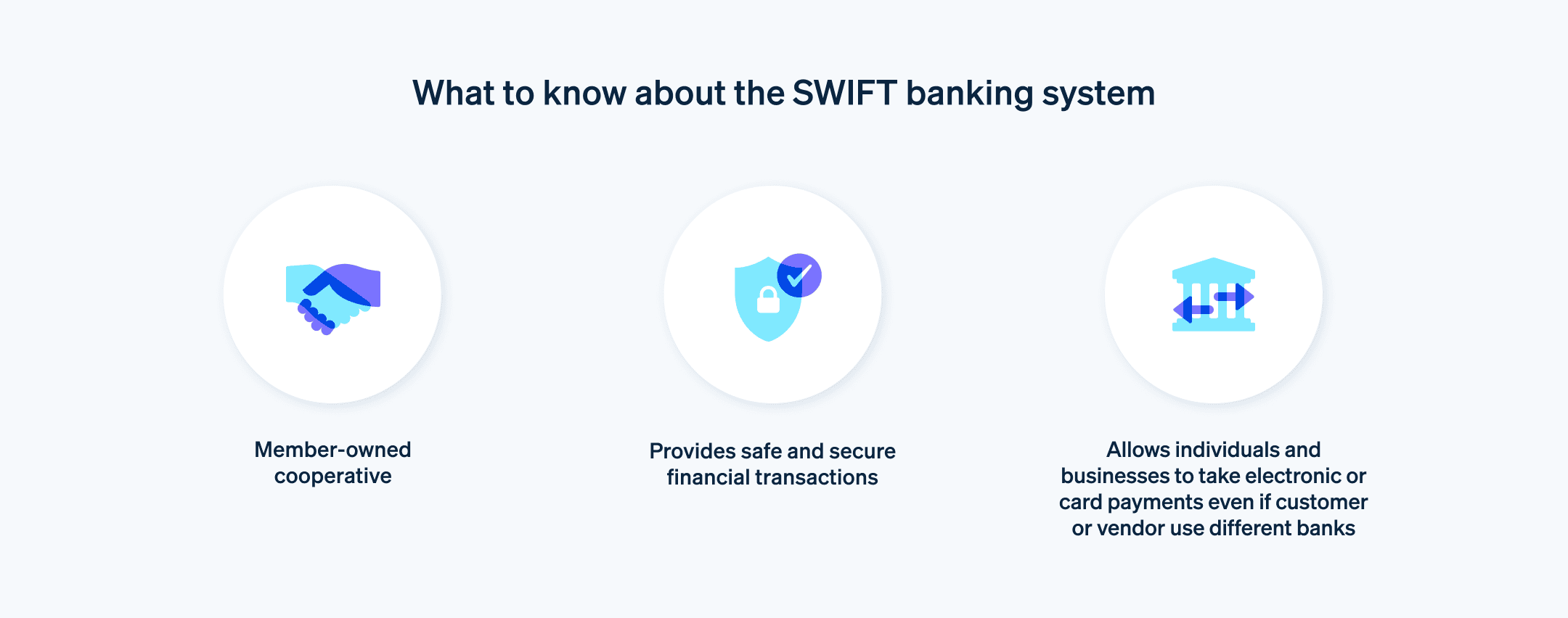国际汇款非常简单。您可以致电您的银行、亲自前往或登录您银行的在线门户,发起到世界上任何地方转账。但是,这些交易究竟是如何运作的,什么样的基础设施支持它们?在大多数情况下,SWIFT 银行系统是该过程的重要组成部分。
与其他支持资金转账的知名网络不同,SWIFT 本身不转移或持有资金,但它仍然是国际金融体系的重要组成部分。以下是您需要了解的有关 SWIFT 是什么、在哪里运作、做什么以及它为何如此重要的信息。
目录
- “SWIFT”代表什么?
- 什么是 SWIFT?
- SWIFT 的历史
- SWIFT 在经济制裁中的作用
- SWIFT 的历史
- 谁在使用 SWIFT?
- 谁拥有 SWIFT 银行系统?
- 什么是 SWIFT 代码?
- SWIFT 如何运作?
- SWIFT 还提供哪些其他服务?
“SWIFT”代表什么?
“SWIFT”是“环球银行金融电信协会 (Society for Worldwide Interbank Financial Telecommunications)”的缩写。
什么是 SWIFT?
SWIFT 是银行间用来相互安全通信的网络,主要用于发出账户之间转移资金的指令。虽然 SWIFT 是全球支付系统的重要组成部分,但网络本身仅用于发送和接收报文,SWIFT 不持有资金、发行或管理账户,也不为交易提供结算功能。
SWIFT 的历史
SWIFT 被认为是对其有缺陷的前身电传的回应。电传是金融机构的早期通信系统,被广泛认为繁琐且容易出错,处理时间是出了名的慢。1973 年,SWIFT 在布鲁塞尔成立,当时有来自 15 个国家的 239 家金融机构参与,这一数字在 4 年内增加到来自 22 个国家的 518 家机构。目前,SWIFT 被位于 200 多个国家/地区的 11,000 多家银行机构使用。2021 年,成员机构平均每天发送 4200 万条 SWIFT 报文。
SWIFT 在经济制裁中的作用
由于 SWIFT 成员资格允许各国轻松进行国际金融交易,因此将其排除在 SWIFT 之外是一种经济制裁,可用于制裁其行为受到全球社会谴责的国家。例如,当俄罗斯在 2022 年入侵乌克兰时,许多俄罗斯和白俄罗斯的银行被从 SWIFT 网络中删除,包括 Otkritie 银行、Rossiya 银行、Novikombank 银行和 VTB 银行。
谁在使用 SWIFT?
尽管 SWIFT 的成立是是为了支持有关资金和代理交易的通信,但报文传送系统的功能远远超出了最初的范围。多年来,SWIFT 的使用范围不断扩大,该网络现在为以下组织和个人提供服务:
- 银行
- 经纪机构和贸易公司
- 证券交易所
- 资产管理公司
- 票据交换所
- 托管机构
- 兑换
- 公司商业机构
- 财资市场参与者和服务提供商
- 进行国际电汇或汇款的个人或企业
- 外汇和货币经纪人
尽管还有其他系统在同一市场中运行,但 SWIFT 仍在继续发展,已成为金融传输的主要网络。这在很大程度上是由于该系统令人印象深刻的可伸缩性、安全性、标准化和可靠性。
谁拥有 SWIFT 银行系统?
SWIFT 不归任何单一实体所有。相反,它是一个成员拥有的合作社,其股东代表约 3,500 个成员组织。该系统总部设在比利时拉胡尔佩,由十国集团国家的中央银行、欧洲中央银行和比利时国家银行监管。SWIFT 股东选举一个由 25 名董事组成的董事会,负责管理组织并监督 SWIFT 系统的管理。董事会负责:
- 管理 SWIFT 组织的日常运营
- 在全球范围内扩展和推广 SWIFT 系统,强调保持中立
- 对 SWIFT 基础设施的安全性、运营可靠性、业务连续性、风险识别和弹性进行监督

什么是 SWIFT 代码?
SWIFT 代码是 SWIFT 分配给使用网络的每个金融机构的唯一标识符。也称为 SWIFT ID 或 ISO 9362 代码,SWIFT 代码有 8 或 11 个字符。以下是字符所代表内容的细分:
- 前四个字符:代表金融机构本身的代码。
- 第五和第六个字符:表示机构所在的国家/地区。
- 第七和第八个字符: 第七和第八个字符是城市代码,表示该机构的位置。
- 第九、十和十一个字符:这些最后的字符是可选的,可用于识别银行机构的各个分支机构。
SWIFT 是如何运作的?
SWIFT 代码是 SWIFT 系统功能的核心。这种标准化的代码结构使金融机构能够使用通用语言进行通信,并准确地发送和接收交易报文。
为了更好地理解 SWIFT 交易,最好不要将它们视为“交易”,而应更多地将其视为“传输”。同样,SWIFT 不是金融机构,不持有资金,也不促进金融机构之间的资金流动。SWIFT 在机构之间传递消息,而不是资金。然而,这些信息有助于资金流动,因为它们使银行和其他金融实体能够轻松安全地就资金转移进行沟通。
SWIFT 还提供哪些其他服务?
除了充当报文传送系统外,SWIFT 多年来还不断扩展,提供一系列旨在支持企业和个人进行商业交易的服务。SWIFT 提供的一些服务包括:
商业智能
SWIFT 为客户提供报告实用程序和仪表板,为客户提供详细、可操作、实时的报文传送和其他活动视图,并根据地理区域、报文时间和其他因素提供过滤选项。合规服务
SWIFT 提供应对金融犯罪和合规的服务。报文传递和连接解决方案
SWIFT 的主要目标是提供一个网络,以安全、准确和可靠的方式在各方之间传输报文。这一使命得到了诸如消息中心、网络连接和软件等产品的支持,这些产品提高了用户发送和接收消息的能力。
本文中的内容仅供一般信息和教育目的,不应被解释为法律或税务建议。Stripe 不保证或担保文章中信息的准确性、完整性、充分性或时效性。您应该寻求在您的司法管辖区获得执业许可的合格律师或会计师的建议,以就您的特定情况提供建议。